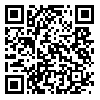1. Nokhbezaein P. Investigation of the effect of reality therapy on promoting responsibility and social adjustment in adolescent females. Pajouhan Sci J. 2021;19(2):43–9. [Persian] [
DOI]
2. Dollar JM, Stifter CA, Buss KA. Exuberant and inhibited children: person-centered profiles and links to social adjustment. Dev Psychol. 2017;53(7):1222–9. [
DOI]
3. Schulte F, Brinkman TM, Li C, Fay-McClymont T, Srivastava DK, Ness KK, et al. Social adjustment in adolescent survivors of pediatric central nervous system tumors: a report from the childhood cancer survivor study: adjustment in survivors of pediatric CNS tumors. Cancer. 2018;124(17):3596–608. [
DOI]
4. Rich D. Kelid haye parvaresh maharaat haye asasi zendegi dar koodakan va nojavanan [The keys to developing basic life skills in children and teenagers]. Gheytasy A. (Persian translator). Tehran: Saberin Publication; 2012. [Persian]
5. Asgari P, Roushani Kh. The comparison of cultural intelligence, emotional intelligence and personal-social adjustment in male and female students of Ahwaz Islamic Azad university. Journal of Women and Culture. 2012;4(12):49–63. [Persian] [
Article]
6. Zare H, Sharif N. Surveying the relationship between thinking styles and self-esteem among high school and pre-university girl students. Journal of Shahed University. 2011;8(2):33–42. [Persian] [
Article]
7. Chen J. A study on the correlations between thinking styles and academic achievement in web-based environmental education. Ekoloji. 2018;27(106):2045–51.
8. Aldossari AT, Abu Jadou MMA. The common thinking styles based on the mental self-government theory among saudi university students according to gender, academic achievement and extracurricular activities. Int J Learn Teach. 2021;20(6):258–76. [
DOI]
9. Eva B. School adjustment of borderline intelligence pupils. [Summary of Doctoral Thesis]. [Cluj- Napoca]: Faculty of Psychology and Education Sciences, University of Cluj-Napoca; 2003.
10. Binaghi M. Rabeteye sabk haye tafakor valedeyn va sazegari ejtemaei dar farzandan pesar aadi va tizhoush [The relationship between parents' thinking styles and social adjustment in normal and gifted boys] [Thesis for MSc]. [Tehran, Iran]: Islamic Azad University of Tehran Branch; 2012.[Persian]
11. James K, Asmus C. Personality, cognitive skills, and creativity in different life domains. Creativity Research Journal. 2001;13(2):149–59. [
DOI]
12. Özcan ZÇ, Eren Gümüş A. A modeling study to explain mathematical problem-solving performance through metacognition, self-efficacy, motivation, and anxiety. Aust J Educ. 2019;63(1):116–34. [
DOI]
13. Vohs JL, Lysaker PH, Francis MM, Hamm J, Buck KD, Olesek K, et al. Metacognition, social cognition, and symptoms in patients with first episode and prolonged psychoses. Schizophr Res. 2014;153(1–3):54–9. [
DOI]
14. Outcalt J, Dimaggio G, Popolo R, Buck K, Chaudoin-Patzoldt KA, Kukla M, et al. Metacognition moderates the relationship of disturbances in attachment with severity of borderline personality disorder among persons in treatment of substance use disorders. Compr Psychiatry. 2016;64:22–8. [
DOI]
15. Pournamdarian S, Birashk B, Asgharnejad F. The role of meta-cognitive Beliefs in depression-anxiety–stress symptoms in nurses of Beast Hospital in Hamedan at 1389–90. Avicenna J Nurs Midwifery Care. 2013;21(2):12–22. [Persian] [
Article]
16. Crocetti E. Identity formation in adolescence: the dynamic of forming and consolidating identity commitments. Child Dev Perspect. 2017;11(2):145–50. [
DOI]
17. Karaś D, Cieciuch J. The relationship between identity processes and well-being in various life domains. Pers Individ Dif. 2018;121:111–9. [
DOI]
18. Martin LJ, Balderson D, Hawkins M, Wilson K, Bruner MW. The influence of social identity on self-worth, commitment, and effort in school-based youth sport. J Sports Sci. 2018;36(3):326–32. [
DOI]
19. Michaeli Manee F. Relationship of identity styles, identity commitment and gender with students’ adaptation with college. Psychological Studies. 2010;6(2):51–74. [Persian] [
Article]
20. American Psychiatric Association. Diagnostic and statistical manual of mental disorders. 5th edition. American Psychiatric Association; 2013.
21. Meyers LS, Gamst G, Guarino AJ. Applied multivariate research, design and interpretation. London: Sage publication; 2006.
22. Hooman HA. Modelyabi mo'adelate sakhtari ba karborde narmafzare LISREL [Structural equation modeling using LISREL software]. Tehran: SAMT Publication; 2018. [Persian]
23. Sinha AKP, Singh RP. The adjustment Inventory for school students (AISS). Agra (India): National Psychological Corporation. 1993.
24. Kumar VV, Mehta M, Maheshwari N. Exploring achievement motivation, adjustment and emotional intelligence of students across different Indian demographic groups. European Academic Research. 2014;2(2):2328–48.
25. Mohammadi Baghmoalaee H, Yousefi F. The structural relationship among teacher-student interaction, academic engagement, and students' adjustment to school. Studies in Learning & Instruction. 2019;10(2):76–100. [Persian] [
DOI]
26. Sternberg RJ, Wagner RK. Thinking Styles Inventory, Unpublished test. Yale: Yale University; 1992.
27. Zhang LF. Thinking styles: university students’ preferred teaching styles and their conceptions of effective teachers. J Psychol. 2004;138(3):233–52. [
DOI]
28. Pooratashi M, Zamani A. Validity and reliability of Thinking Style Scale amongst agricultural students. Quarterly of Educational Measurement. 2016;6(24):103–21. [Persian] [
Article]
29. Cartwright-Hatton S, Mather A, Illingworth V, Brocki J, Harrington R, Wells A. Development and preliminary validation of the Meta-Cognitions Questionnaire-Adolescent Version. J Anxiety Disord. 2004;18(3):411–22. [
DOI]
30. Khoramdel K, Sajadian P, Bahrami F, Zangene S. Validation of the Adolescent Meta-Cognition Questionnaire Version. Zahedan J Res Med Sci. 2012;14(1):29–36. [Persian]
31. Berzonsky MD. Identity style and coping strategies. J Pers. 1992;60(4):771–88. [
DOI]
32. Khodaie A, Shokri O, Crosity E, Garavand F. Factor structure and psychometric properties of the Identity Style Inventory (ISI). Advances in Cognitive Sciences. 2009;11(1):40–8. [Persian] [
Article]
33. Shahrarai M. Ravan shenasi roshd nojavanan didgahe tahavoli [Developmental psychology of adolescents transformative perspective]. Tehran; Elm Publication; 2013. [Persian]
34. Berzonsky MD, Kuk LS. Identity style, psychosocial maturity, and academic performance. Pers Individ Dif. 2005;39(1):235–47. [
DOI]
35. Yousefzadeh M, Yaghoobi A, Rashidi M. The impact of metacognition skills instruction on secondary school girl students’ self-efficacy. Journal of School Psychology and Institutions. 2013;1(3):56–68. [Persian] [
Article]
36. Marin LM, Halpern DF. Pedagogy for developing critical thinking in adolescents: explicit instruction produces greatest gains. Thinking Skills Creat. 2011;6(1):1–13. [
DOI]

 ، مسعود قاسمی*2
، مسعود قاسمی*2 
 ، مژگان سپاه منصور3
، مژگان سپاه منصور3 




